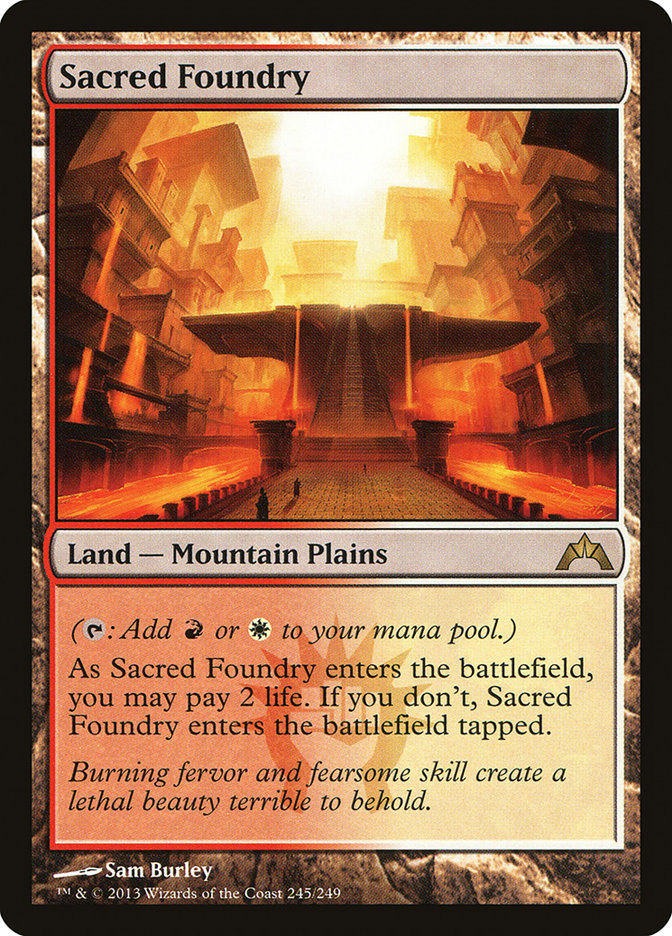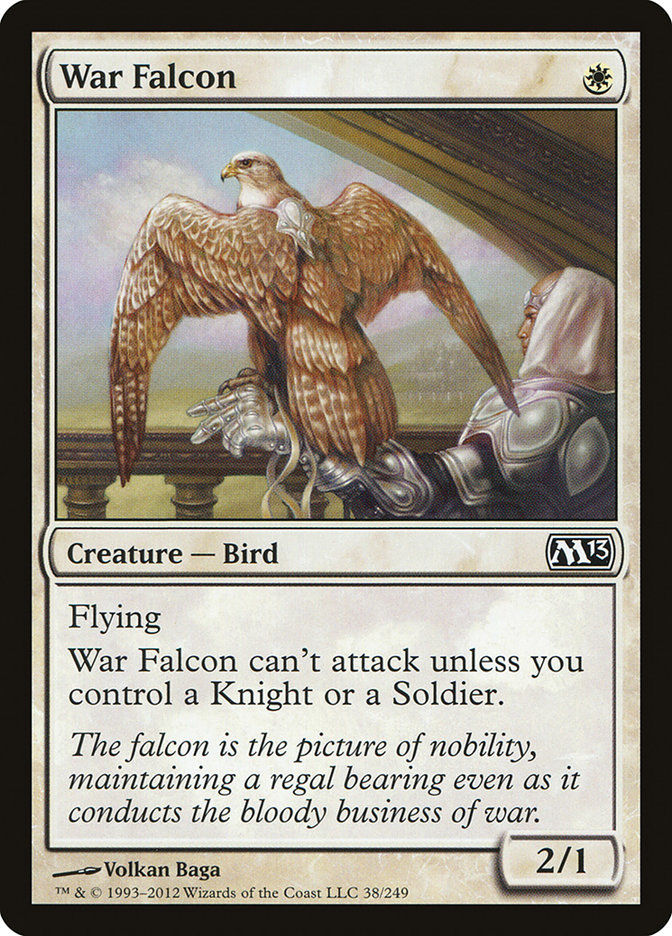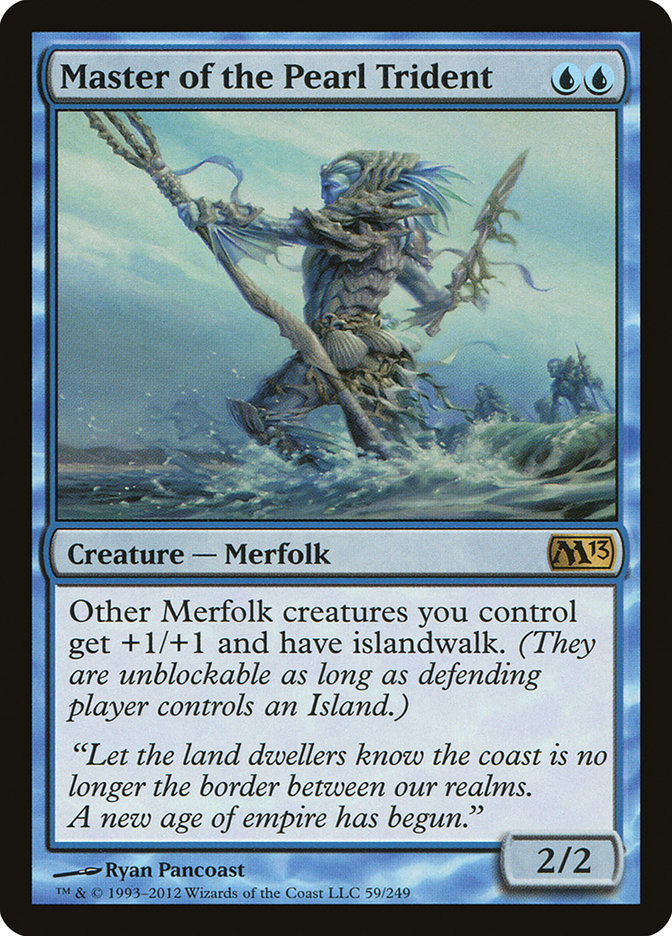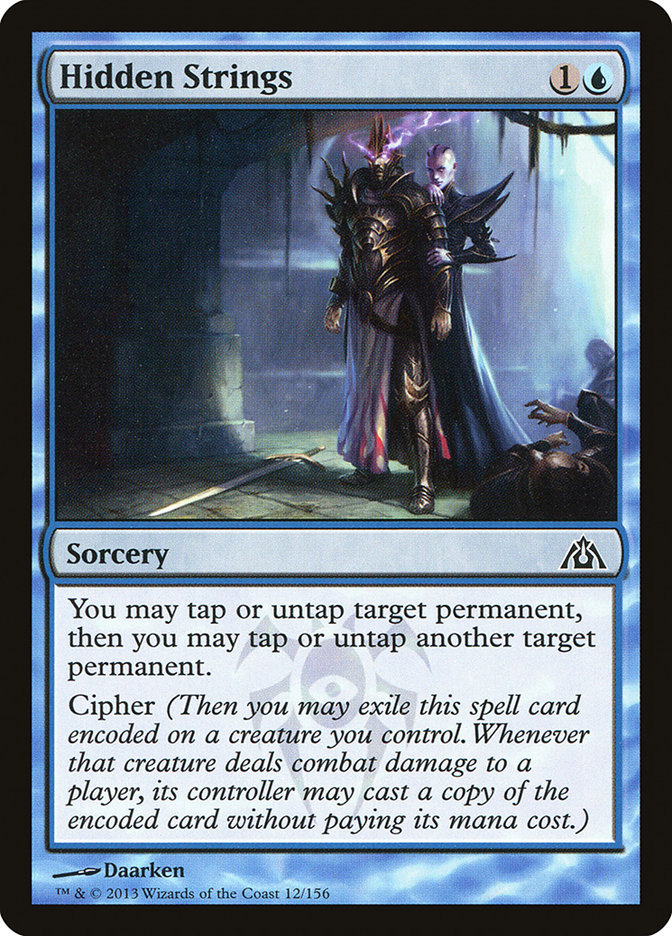Life is full of awkward conundrums. When you applied (or apply, if you’re a young whippersnapper) for your first job, you will find that there are some strangely cyclical clauses that accompany your potential for your employment. Jobs often require you to have reliable means of transportation (i.e., a car), but if you’re just starting out after college or high school, you can’t afford a car. But you need a job to pay for a car. But you can’t get the job without a car. Similarly, experience for jobs is a big catch—you need experience for Job X, but Job X will give you that experience and you can’t get experience without Job X. Job X is a real stick in the mud.
This can be applied to many different facets of our lives: education, applying for credit, our love lives, and, oh yes, Magic too. Once you’re "in," it’s easy, right? But what if you need to get in?
As this is a Magic article, let’s tackle that problem. Say you have a friend that you’ve taught Magic and he or she is very excited to get into the game. You give them some of your Standard slop, maybe a few rares here and there to start them up, but they are still struggling to put together a deck that they like or that they feel is effective or competitive even at the lowest level. Sure, they’d love to play in Friday Night Magic, but their deck full of Silvercoat Lions and Sentinel Spiders may not have what it takes even for an event that simple.
Magic can be an expensive hobby, especially depending on the financial situation of many of its skyrocketing group of new players. Some are students, young adults living off a small paycheck, or their money is tied up in other ways. Whatever the situation is, those people can still have a ball playing Magic. Wizards has been addressing this problem with Event Decks, which are great tools to start playing in local events. Event Decks are great, but they are often diluted versions of much more powerful decks and have lots of room to grow and expand as you obtain the trendy cards of the format. Costly creatures and pricey planeswalkers fill up the best decks, but one of the most prohibitive expenses of getting into Constructed Magic is the most menial of them all: lands.
One copy of this could buy four gallons of gas, ten loaves of bread, or a used season of Battlestar Galactica DVDs. Think about it.
Newer players see these dual-colored lands as opulent luxuries or financially unattainable based on their cost and/or the reluctance of traders to part with them for anything less than their entire binder of bulk rares. You can try to get by on Guildgates or Evolving Wilds alone, but the truth is that decks that need two, three, or more colors to function are miserable when you don’t have the right colors while playing on a budget mana base. This can lead to a lot of unpleasant experiences at the Friday Night Magic tables for new players just out to have a good time with their pals. Mana bases for a three-color deck average about $200 these days, and that’s more than a lot of Magic players can (or want to) pay.
I want to share two decks today that solve this problem. If you’re a new player and you don’t want to play with a deck that feels like a bracelet with all the diamonds and gold stripped out, maybe you should give these a try. Each of these decks is "final," meaning that there is no more money you need to spend once this deck is created unless you want to deviate from the deck’s plan. I don’t give budget versions of better cards; these are the affordable best options given the deck’s strategy. To avoid the mana cost issue, each of these decks is only one color and uses only basic lands to provide mana.
Knight Weenie
Aggressive decks tend to be more cash-friendly (tend being the operative word,) so we’ll start there with a mono-white offering based on bringing a very powerful and utterly unplayed card front and center.
War Falcon, a high-power low-cost evader, got a flutter of excitement upon its spoiling a year ago and then never squawked again. While it can only attack with a Soldier or Knight in play, shouldn’t a team of Soldiers and Knights do the trick? I’d like to think so. I’ve mustered the best ones I can find to bring about this tribal-focused white…er…"Knight" Weenie deck.
Creatures (29)
- 4 Thalia, Guardian of Thraben
- 3 Silverblade Paladin
- 2 Angel of Jubilation
- 4 War Falcon
- 4 Dryad Militant
- 4 Precinct Captain
- 4 Boros Elite
- 4 Daring Skyjek
Lands (23)
- 23 Plains
Spells (8)
Sideboard

For those of you keeping track at home, this deck runs just shy of a Benjamin at $98.68 at the time this article was written based on StarCityGames.com pricing.
Creatures
This deck sports 24 creatures that can enter the battlefield by turn 2 without having to worry about multiple colors of mana or what to put your Cavern of Souls on, mind you. Every card except Angel of Jubilation turns War Falcon on, so you can rely on landing two evasive points of damage right off the bat. Dryad Militant and Boros Elite both pack a wallop after just a turn or two. Daring Skyjek, alongside other evasive creatures like Precinct Captain and War Falcon, can take your opponent’s life total away in chunks.
Thalia, Guardian of Thraben does very little to interfere with your own game plan while putting any spell-wielding opponent a turn behind. Regardless, she can often apply enough tempo advantage that she quickly turns from a little Youthful Knight to be a must-answer problem. With all the Voice of Resurgence, Burning-Tree Emissary, and Snapcaster Mage copies floating around on the biggest tables, two power of first strike has never been more relevant.
The two heavier creatures, Silverblade Paladin and Angel of Jubilation, can easily turn a hardened battle into a one-sided smash fest. Silverblade Paladin bound with any of the evasive creatures presented here can create an unexpected threat. Angel of Jubilation, also woefully underplayed, is exceptional at shutting down sacrifice-based decks as well as providing a highly valuable anthem effect for the team. This card shuts down Aristocrats pretty hard, and the steep mana color weight is no sweat here. It’s slow (for this deck), and you’ll rarely need two, so I’ve included only a pair.
Spells
The eight spells in this deck were carefully tested and chosen based on the needs of this deck. First, Bonds of Faith. This tempo-based removal spell can pin down a problem creature or buff your Human to impressive heights. Both battalion creatures in this deck benefit from this effect, making an otherwise awkward attack into a powerful war cry. Human-based decks have been using Bonds of Faith for the last eighteen months, and it’s welcome here as a flexible and budget-friendly removal option.
Nevermore is a bit different. Nevermore is a powerful card; Meddling Mage and its variants have danced around in Standard since Magic first introduced them. In this deck, I want Nevermore to be a proactive card that can protect your team for whatever threat you fear most, most likely some kind of impassable creature or sweeper effect. Nevermore often slides into sideboards and many hesitate to bring it in, but here it is an essential part of Knight Weenie’s insurance. By the time you cast this (turn 3 or 4), you will have seen a few spells and lands from your opponent.
A bit of metagaming knowledge is needed for Nevermore to be its most effective, but the element of surprise you will bring when you cast it should be worth the work. Fighting Esper Control? Name Supreme Verdict or Terminus. Naya colors staring back at you? Perhaps Thragtusk or Mizzium Mortars might be the right choice. A B/R/X opponent? Call Olivia Voldaren, Bonfire of the Damned, or even Abrupt Decay or Putrefy. Sometimes, when I play control decks, I’ll often loose keep if I have a sweeper in hand. Punish opponents who are banking on their ringer to get them there.
Sideboard
Starting off, Boros Reckoner is a bit of a no-no for staying on a budget; its price tag makes up nearly half the deck’s budget. Although it is an invaluable card in mirror aggro matchups, you could get by without it. It isn’t exactly on theme (it’s a Wizard, Harry), but it’s just so good in those matchups. No worries; the cheaper Knight of Glory is another great alternative as a four-of. Rootborn Defenses protects your team from nominal removal or big kahuna sweepers. Use it as an extra line of defense against those pesky control decks.
Mentor of the Meek was a favorite of mine back in my U/W Human days pre-RTR, and he helps you outpace a low-removal high-threat deck. Sundering Growth is Disenchant; the populate only affects Precinct Captain, and I’m not excited about copying 1/1s. Detention Sphere, Assemble the Legion, and Keyrunes do still float around, so it never hurts. Rest in Peace is your basic anti-Reanimator. Play ’em if you need ’em.
Ok, so you might be chiding me for being too expensive. $100 is still expensive for a large population of Magic players just looking to improve their game on a Friday night. Alright, you asked for it.
Nickelfish
Merfolk. A Legacy-playable tribe of fish people. I know I’m not the only one that has been standing vigil for good Merfolk prints since this spoiled last June, and we have all been disappointed; Merfolk of the Depths isn’t winning any awards for efficiency. In M13, where Master of the Pearl Trident made its debut, though, reasonable Merfolks emerged, and since then support from unlikely places in Ravnica have lent this deck a bit more stock. This mono-blue cast-and-copy deck will thrill a wide variety of players from budget Johnnys to tribal junkies. Let’s dip our toe in.
Spells (21)
- 3 Dissipate
- 1 Syncopate
- 4 Think Twice
- 1 Sleep
- 2 Silent Departure
- 3 Cackling Counterpart
- 3 Hands of Binding
- 1 Biomass Mutation
- 3 Hidden Strings
Sideboard

$38.51. That’s more like it.
Creatures
Although I could bore with you some made-up, highfaluting explanation of the choices of these creatures, there are only nine Merfolk in Standard, and narrowing that down wasn’t even tough. Two are multicolored, and the other three are hilariously unplayable. Thus, we’re left with these four sets of four. Augur of Bolas, the only creature that sees any real Standard play anymore, is a great wall and can often gain you back value by grabbing you a spell. For this deck, I got about a 60% return on my investment (I counted in playtesting), and many successful triggers offered two or three choices. Scroll Thief is a very, very expensive 1/3 that occasionally has upside. It’s clearly the worst Merfolk that made it in, but I needed something. Besides, Curiosity almost never hurts anybody.
Our two big fishes are next. Master of the Pearl Trident is the actual best card in the deck. You will want infinity of them at almost every point in the game. Islandwalk will sometimes be relevant, but making your 1/3s 2/4s makes a surprising difference in combat. 2/4s live through a decent amount, and 3/5s trade with Tusks. If your opponent is playing Islands, fuhget abaht it. Talrand, Sky Summoner is here as a playset because yes, he will die a lot and you will always want another one. The spells are very complementary to him, and you’ll be able to summon an army of Drakes in no time at all.
Spells
First up, let’s look at Think Twice. This boring yet somehow fun cantrip makes sure your counter mana doesn’t go to waste if they chicken out on casting their main phase spells. Dissipate, another easy cast off all blue mana, is the best hard counter in Standard; the double blue is often a hindrance, but here that ain’t no thing. Syncopate, which appears as a single copy, can still counter something on turn 2, and that one moment makes it a hair better than four of the same counterspell.
The cipher spells are the real fun part, namely Hidden Strings.
This card is kind of a do-nothing card unless it’s in the right hands (which in this case seem to be scaly, slippery, ichthyic hands). It effectively casts for free (untap the Islands you use to cast it) and can actually ramp you if you use it correctly. Its best application is getting it out on an early drop and resolving Talrand on time then gaining him a Drake right away from a cipher trigger. It does help you use your Think Twice in response to the cipher damage trigger and get a free card. Hands of Binding acts as conditional removal that also helps you force damage through. I’ve tried this sorcery in a variety of decks since its release, but never has a deck needed this effect as badly as this one.
Cackling Counterpart is also a standout in this deck. When countering is irrelevant, copying any of your creatures can be an option. Obviously, Master of the Pearl Trident is the best target. Then, the copy gives islandwalk to all your creatures, including the original lord, and that level of power is, well, not very common in blue. It also acts as a counterspell to removal. You’d like to Pillar of Flame my Master? Be my guest; I’ll just copy it! After the new legend rule takes effect, you can even copy Talrand in response to removal so he lives on. It gives a nice, reactionary feel to an effect that rarely happens at instant speed.
Silent Departure, helpful for being useable twice, is a bit more interesting than Unsummon, and so far I’ve been grateful to have two shots. Without Snapcaster Mage money, we have to improvise. Sleep and Biomass Mutation are finishers for different circumstances. Sleep lets you bash once (or twice) unimpeded while protecting you from a backswing if you are having trouble getting through and Islandwalk isn’t cutting it. Biomass Mutation acts as an Overrun for a high-life opponent who is living large behind their army of huge bruisers. Every creature in this deck is fairly anemic at two or less power, and turning them into bigger creatures can help you surprise an unsuspecting foe. Master of the Pearl Trident will still grant bonuses, so bear that in mind too!
The sideboard is pretty sloppy; Negate and Dispel come in for the must-counter-everything decks, and Rapid Hybridization handles special utility creatures and problematic large ones. Downsize is a really nice Fog effect for blue, as it lets you kill something if you need to and it’s cheap enough to eke one out after resolving Talrand or alongside another more relevant spell. Mizzium Skin answers Jund and Esper decks that just always have the removal to finish off one of your few creatures. It’s still a great answer to Abrupt Decay, and they’ll never see it coming.
I playtested this one extensively and had a blast doing it. All the fun interactions, tapping and untapping, were a lot of fun. My hand was always full of cards, and it was easy to reload after a sour removal spell. It had trouble with a lot of decks, though, so there is no doubt there is a disparity in power level compared to top tier decks. But hey, you spent the same amount on this as you would for a used Xbox game.
I was able to sneak away with wins against all of the U/W/X variants, including USA Flash and Bant. Those decks relied heavily on life gain and sweeper effects to clear the board but were often mitigated by nearly guaranteed evasion and the card advantage I managed to produce. Jund and Aristocrats were real problems though. As your budget allows, changing the sideboard to your local metagame is highly recommended. Either deck could board in Pithing Needle or Tormod’s Crypt based on your needs.
I’m sure that the power level of Knight Weenie is higher than our Fish deck, but at a price point difference. Pick the one that’s right for you and give it a try!
Last week, I mentioned starting a weekly variant-based community deckbuilding activity. For those of you who didn’t read it, I’ll ask for decks each week that fill particular parameters based on format, card type, and variant game styles. This is meant to be an exercise in deckbuilding, research, and community construction. Feel free to leave your decklists in the comments below, or email them to my Untapped email, [email protected]. If your deck isn’t immediately obvious, it wouldn’t hurt to add a little description of the game plan that I can pass along.
For our first week, let’s do something to celebrate the diversity of Ravnica!
The Guildpact
Format – Standard
- Every card in your deck must be either multicolored (non-hybrid) or colorless (artifacts and lands).
- The deck must contain at least two cards from each of the ten guild color combinations and no more than eight cards from any one guild color combination. For example, you could have two copies of Sphinx’s Revelation to fulfill your Azorius count, but playing four Spike Jesters and four Hellhole Flailers would prevent you from adding any more Rakdos cards.
- Nicol Bolas, Planeswalker, the only three-color card in Standard, does not count towards any guild but can still be used.
- Normal deckbuilding besides that (minimum 60 cards, no more than four of any card beyond basic lands.)
- Sideboards aren’t required.
Take your creativity up a notch and build that Prismatic deck! I’ll select some of my favorites to highlight in two weeks on July 16, 2013, so make sure to get them in by July 14, 2013. Good luck and remember, have fun! Brewing is the best part of Magic!
Starting next week, I’ll be digging into M14, which will be just on the horizon. There are lots of cards I’m excited to see affect Standard, and I’ll share some thoughts with you. Until next week, don’t forget to untap!
– Matt
CaptainShapiro on Magic Online




